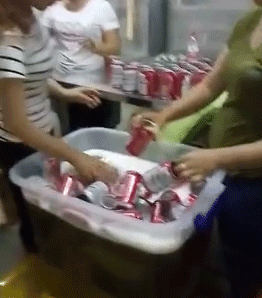The Weirdest Products That Scammers Have Counterfeited
by Ian Fortey
They say money can't buy happiness, but it can definitely buy everything else. Things like burritos and flamethrowers ... so in essence, yes, it can absolutely buy happiness. Getting that money can be tough, though, which is why counterfeiting currency has long been an issue. But as we've discussed in the past, it takes a heck of an effort, because they put a lot of fine details into physical money. And maybe that's why some people just sidestep counterfeiting cash, which is hard, and counterfeit random things they can sell for cash, which can be way easier ... and way weirder.
Ever Had a Counterfeit Egg?
The counterfeit food industry is just booming in China, and if you can't wrap your head around how food can be faked, don't worry. Even after you see how it's done, you'll still be baffled and also terrified of every meal you make for the rest of your life.
Since the 1990s, egg bandits in China have been faking eggs to make a buck. In the Western world, this is hard to understand since an egg is pretty cheap, but they're a highly sought after item in China and other countries in the East. They're pretty difficult to get in parts of India, for instance. Counterfeiters, however, can make 1,500 fakes in a day, which shames even your most awesome, fully-automatic, machine gun-style chicken. So what the heck is a counterfeit egg, exactly?
An egg counterfeiter makes an egg in three parts. You start with the yolk, mixing color in a mold with some starches, benzoic acid, gelatin and color. Dip it into a coagulant mix, and it forms into the exact color, shape and texture of a yolk. Next, use a very similar mixture minus the color to make the egg white. Then embed the yolk and coagulate again. To the naked eye, it looks precisely like an egg out of the shell. In the final bit of weirdness, you put the mix in a fake shell mixture: wax, calcium carbonate and gypsum powder. Dip the fake egg in the shell mix, take it out and it dries to a hard, white or brown coating, almost impossible to distinguish from a real egg shell.
The fake egg may be larger and a little smoother than a real one. The yolk won't have that creepy membrane around it, and if you break the yolk, it'll mix super fast into the white. You can even cook the thing and it'll turn white, but it's definitely going to taste less like egg and more like your shoe insole. Oh, and it has the added benefit of causing potential liver and nerve damage.
How About a Fake Budweiser?
Budweiser was invented in 1624 by Chad Beer, and I'm not doing the research to verify that. You have Google. It's not important to understand this story. What is important is that it's one of the world's top selling beers. People love it for its beer flavor and beer color and because it's beer. But real Budweiser is expensive, fluctuating between $6-$10 for a six-pack in the States, depending on which store is screwing you the most ... while the cost of beer is about half that in China.
Budweiser has made big inroads in China; there are over a dozen Bud breweries there, and it's one of the top selling beers in the country. Maybe that's what inspired someone who makes less popular beer to start filling empty Bud cans with random beer and selling them. And if that just sounds "meh" to you, then you need to have a better appreciation of just what this means.
They're not just re-labeling a can of cheaper beer, like a knock off D&G handbag that never really went with those new slacks we bought. Video was taken at a factory, showing workers dunking topless cans into plastic tubs full of beer. They just bare-hand that bad boy right into a Rubbermaid tote full of brew and then set it on a conveyor belt, where it then goes down the line and has a top slapped on it. By the time they get to the bottom of that bin, with three or four of them doing it, if that can isn't half beer and half palm sweat and fingernails, count yourself lucky.
This was no small operation either, despite how ramshackle that sounds. They were churning out 600,000 crates per month, meaning it's likely that millions of people now know what it tastes like to be slapped in the tongue by a factory worker.
Not Even Popsicle Sticks are Safe
Remember buying popsicles when you were a kid? Or, you know, when you were an adult and got to dictate your own breakfast? They're delightful and refreshing; go get one after reading this. Then check the stick, because sometimes the more awesome popsicle makers of the world run contests where the stick will have something written on it. And sometimes, those words mean you won something.
In Turkey, there were some you could trade in for a free ice cream if you got lucky. Naturally, this means buying one popsicle and getting the right stick. But a pair of enterprising frauds figured it'd be better if they skipped the popsicle part and just had winning sticks. So they faked them.
It's the hard-knock life for us.
"Who wants ice cream that bad," you might ask. Aside from everyone, the two fraudsters had devised a pretty crafty scheme of exchanging the sticks at supermarkets until they had a bulk quantity of ice cream, then selling the ice cream at a discount to different supermarkets. They were fairly successful for three years and even had a machine set up to print the sticks just for this purpose.
If you're wondering how anyone catches on to a counterfeit popsicle stick racket, it's a simple numbers game. The stores that were given the fake sticks had to send them back to the ice cream company in order to be reimbursed. The company eventually realized they were getting more sticks back than they were even producing, and they called law enforcement. And if your brain just produced the phrase "ice cream police," we're kindred spirits. And we freely offer that idea to Marvel for their next issue of Deadpool.
Even Condoms Can be Counterfeited
Though we live in a disposable culture and a lot of what we consume is meant to be thrown away, there are a handful of products you want to make sure function at 100% efficiency, regardless of the fact that you may only be using it for three minutes. Like condoms. Like grandma used to tell us, "You want a reliable, well made condom. Always check them to make sure they're not counterfeit."
The counterfeit condom industry is a bit of a worldwide scourge. They've made their way across Asia, through Europe, Africa and Australia. In Ghana, over 110 million of the things were confiscated in 2013, because they're not just regular condoms being sold with a fake brand name ... they're barely better than wrapping your stuff in a shopping bag and saying a prayer. They're bizarrely undersized, literally full of holes and may burst at any moment, like a kind of sexy-time Russian Roulette.
Nope. Not going there.
They've shown up as recently as 2017 in Puerto Rico, where health officials warn they won't protect against pregnancy or disease. You'd have better luck trying to cook chowder in a pasta strainer.
Because the fakes aren't produced under any kind of standards, what you get are inferior materials. Some counterfeits confiscated in the UK were found to have been lubricated with hand cream, which is a step above using wishes but still below anything you're going to want to trust your future to.
Quick, Natural Snacks Like Walnuts and Grapes? Yeah, Those, Too.
Walnuts are the Shemp of the nut world: they exist, you tolerate them, but come on. They're no almonds. Still, some people have a hankering for a walnut every so often and are willing to bludgeon that insane armored car of a shell and enjoy the vaguely gritty, often dirty-tasting meat within. If you're one of those people, we don't judge you.
In China, walnuts are big business. Not just for food, but as status symbols. They sub in for stress balls -- people just grab a couple and spin them around their palm, supposedly to stimulate circulation. That doesn't seem like a big deal, but there's more to it. If you can get larger than average nuts (stop it), that's worth a premium. If you can get two that are identical, that's worth even more. A pair of super nice nuts back in the day cost $50 (no, seriously, stop it -- we're all adults here). Then, around 2012, the prices skyrocketed as people started investing in them as a commodity. A pair were suddenly worth $5000. They didn't grant wishes or anything. We're talking about just normal, non-magical walnuts.
His food bank is worth more than your car.
With all this interest in nuts as a status symbol, came the inevitable industry of using the ones that aren't good enough as food. But that industry got scammed big time when someone figured out that you could double down on profit. Open the nut, take out the meat and sell it. Then, fill the shell with rocks or concrete and paper (as a buffer so it doesn't rattle), then glue it shut again. You just double dipped in the nut pond.
Now that you have your nuts in order, you need your grapes. If the counterfeit food market in China has proved nothing else, it's that vaguely round foods can be completely faked with ease. A grape can be forged with the same basic mixture that goes into a fraudulent egg, only this time you toss in a bit of real grape juice and color. That gives you a grape with the look and smell of the real thing, which is probably enough to trick a few people at a roadside stand before you pack up shop and head on to the next spot.
Is the joke here that you can full-on counterfeit Grape-Nuts? No. That's a totally different, delicious product and a bad joke to boot. We're ashamed that you made it.









